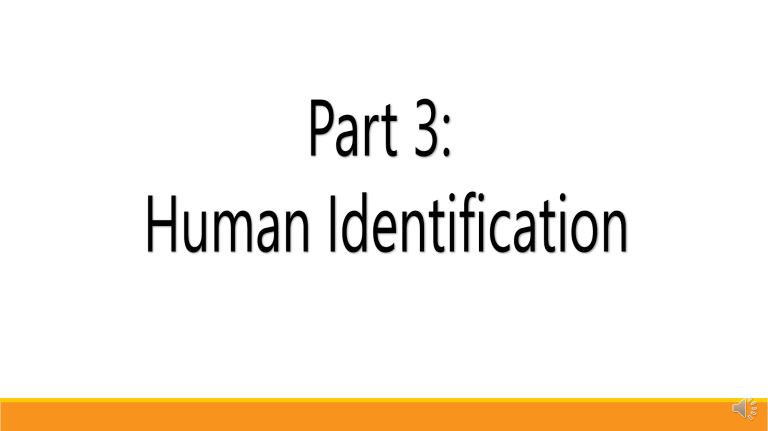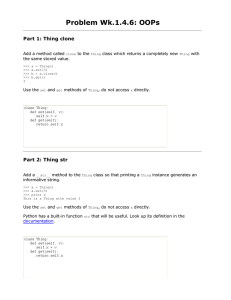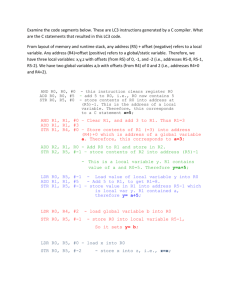
Use of Polymorphic Markers for Human Identification • Ancestry / anthropology studies • Paternity testing Individual identification • Maternity testing Typically only in cases of war / natural disasters • Forensics Gender identification Individual identification Ancestry Testing Three general approaches • Maternal lineage – Mitochondrial DNA testing • Paternal lineage – Y chromosome testing • General lineage – Admixture testing Maternal Lineage: mtDNA Polymorphisms • Mitochondria are maternally inherited • All maternal relatives will have the same mitochondrial sequences • Mitochondrial typing can be used for legal exclusion of individuals or confirmation of maternal lineage http://www.forumbiodiversity.com/showthread.php/43295-23andme-results Maternal Lineage: mtDNA Polymorphisms • Sequence differences in the hypervariable (HV) regions and throughout the mitochondrial genome are used in mtDNA analysis Paternal Lineage: Y-STR Analysis • The Y chromosome is inherited in a block without recombination • Simple tandem repeat (STR) sequences are analyzed on the Y chromosome • Y chromosome STRs are inherited paternally as a haplotype http://www.promega.com/resources/profiles-in-dna/2012/variability-of-new-str-loci-and-kits-in-us-population-groups/ Paternal Lineage: Y-STR Analysis • Allelic ladders for YSTR loci in a multiplex format – the Y-Plex 6 system. • A single haplotype for the Y-STR loci M1 M2 M4 M3 M5 M6 Paternal lineage: Y-STR analysis Admixture Testing • Does not use mitochondrial DNA or Y chromosome analysis • Focuses on analysis of the 22 pairs of autosomes • This is also called autosomal DNA (atDNA) testing • Analyzes STR and/or SNP http://blogs.discovermagazine.com/gnxp/2010/07/really-fine-grained-genetic-maps-of-europe/#.VSVG7eEyg5o Admixture Testing http://www.dailymail.co.uk/sciencetech/article-2931700/The-rise-rise-family-historyDNA-tests-AncestryDNA-s-kit-latest-launch-UK-relatives-SECONDS.html Paternity Testing • Used to legally exclude a male as a potential father of a child • Can use many techniques • Most common technique is now STR analysis http://www.ctdrugtest.com/?p=107 Paternity Testing– RFLPs • RFLP genotypes are inherited. • For each locus, one allele is inherited from each parent. Thought question: What if both parents were homozygous for same allele at locus A? Paternity Testing– RFLPs • Which man’s genotype does not exclude him from being the father? STR Analysis for Parental Testing • STR genotypes are inherited, one allele is inherited from each parent • STR is PCR amplified then resolved by electrophoresis (gel or capillary) NOTE: AMEL loci is not an STR Thought question: Why is the TPOX loci in the child’s sample not labeled with parental origin? STR Analysis for Parental Testing Which of the potential father’s genotype is consistent with the child’s alleles? Not informative Supports #1 Not informative Not informative Supports #1 Not informative Not informative Not informative Forensics • Human remains • Criminal suspects Gender identification Individual identification http://www.fayetteville-crime-scene-cleanup.com/ http://blog.illumina.com/blog/illumina/2013/10/17 /next-generation-sequencing-technologies-andforensic-dna-analysis Gender Identification • The amelogenin locus is not an STR; it is a gene. • The human AMEL gene codes for amelogenin-like protein. • The gene is located at Xp22.1–22.3 and on the Y chromosome. X allele = 212 bp Y allele = 218 bp Males (X, Y) - heterozygous Females (X, X) - homozygous RFLPS in Crime Scene Evidence Locus A 1 = suspect 1 2 = suspect 2 C = child victim P = parent of child victim E = Evidence from crime scene Why include child and parent? Which suspect is consistent with the evidence? Locus B STR Analysis in Crime Scene Evidence http://www.forensicsciencesimplified.org/dna/img/SInglesourcematch.png CODIS: Combined DNA Index System Local DNA Index System (LDIS) State DNA Index System (SBIS) National DNA Index System (NDIS) • • • • CODIS, launched by the FBI, is now the largest DNA database in the world Requires specific STR loci to be analzyed Kits are commercially available for the CODIS STR alleles. The data generated data are digital which can be banked more readily (i.e. creating a national database). • In 2007, CODIS contained almost 200,000 forensic profiles and over 5 million offender profiles • As of the end of 2012, CODIS had produced over 200,000 matches or “hits” This aided in over 190,000 investigations CODIS http://en.wikipedia.org/wiki/File:Codis_profile.jpg Interpreting Polymorphism Analysis Results for ID • Probability of ‘unique’ match with STR and/or haplotype (SNP) analysis increases with each loci added to the analysis. Use likelihood ratios to determine probability of unknown being a match to a sample in the database THE END

